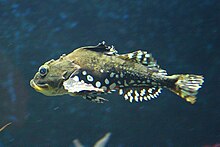| Cottidae | |
|---|---|

| |
| Cottus cognatus | |
|
Scientific classification
| |
| Domain: | Eukaryota |
| Kingdom: | Animalia |
| Phylum: | Chordata |
| Class: | Actinopterygii |
| Order: | Scorpaeniformes |
| Superfamily: | Cottoidea |
| Family: |
Cottidae Bonaparte, 1831 [1] |
| Subfamilies and genera | |
|
see text | |
The Cottidae are a family of fish in the superfamily Cottoidea, the sculpins. It is the largest sculpin family, with about 275 species in 70 genera. [2] They are referred to simply as cottids to avoid confusion with sculpins of other families. [2]
Cottids are distributed worldwide, especially in boreal and colder temperate climates. [2] The center of diversity is the northern Pacific Ocean. [2] Species occupy many types of aquatic habitats, including marine and fresh waters, and deep and shallow zones. A large number occur in near-shore marine habitat types, such as kelp forests and shallow reefs. They can be found in estuaries and in bodies of fresh water. [2]
Most cottids are small fish, under 10 cm (3.9 in) in length. [3]
Taxonomy
The Cottidae was first recognised as a taxonomic grouping by the French zoologist Charles Lucien Bonaparte in 1831. [1] The composition of the family and its taxonomic relationships have been the subject of some debate among taxonomists. The 5th edition of Fishes of the World retains a rather conservative classification, although it includes the families Comephoridae and Abbyssocottidae as subfamilies of the Cottidae recognising that these taxa are very closely related to some of the freshwater sculpins in the genus Cottus. [4] Other workers have found that Cottidae is largely restricted to the freshwater sculpins, i.e. Cottus, Leptocottus, Mesocottus, Trachidermus, and the species flock in and around Lake Baikal, and the marine genera are placed in the Psychrolutidae. [5]
Genera


The genera of the family include: [4] [6]
- Subfamily
Cottinae
Bonaparte, 1831
- Alcichthys Jordan & Starks, 1904
- Andriashevicottus Fedorov, 1990
- Antipodocottus Bolin, 1952
- Archistes Jordan & Gilbert, 1898
- Argyrocottus Herzenstein, 1892
- Artediellichthys Fedorov, 1973
- Artediellina Taranetz, 1941
- Artedielloides Soldatov, 1922
- Artediellus Jordan, 1885
- Artedius Girard, 1856
- Ascelichthys Jordan & Gilbert, 1880
- Asemichthys Gilbert, 1912
- Astrocottus Bolin, 1936
- Atopocottus Bolin, 1936
- Bero Jordan & Starks, 1904
- Bolinia Yabe, 1991
- Chitonotus Lockington, 1879
- Clinocottus Gill, 1861
- Cottiusculus Jordan & Starks, 1904
- Cottocomephorus Pellegrin, 1900
- Cottus Linnaeus, 1758
- Daruma Jordan & Starks 1904
- Enophrys Swainson, 1839
- Furcina Jordan & Starks, 1904
- Gymnocanthus Swainson, 1839
- Icelinus Jordan, 1885
- Icelus Krøyer, 1845
- Leiocottus Girard, 1856
- Leocottus Palmer, 1961
- Lepidobero K. J. Qin & X. B. Jin, 1992
- Leptocottus Girard, 1854
- Megalocottus Gill, 1861
- Mesocottus Gratzianov, 1907
- Micrenophrys Andriashev, 1954
- Microcottus Schmidt, 1940
- Myoxocephalus Tilesius, 1811
- Ocynectes Jordan & Starks, 1904
- Oligocottus Girard 1856
- Orthonopias Starks & Mann, 1911
- Paracottus Taliev, 1949
- Phallocottus Schultz, 1938
- Phasmatocottus Bolin, 1936
- Porocottus Gill, 1859
- Pseudoblennius Temminck & Schlegel, 1850
- Radulinopsis Soldatov & Lindberg, 1930
- Radulinus Gilbert, 1890
- Rastrinus Jordan & Evermann, 1896
- Ricuzenius Jordan & Starks, 1904
- Ruscarius Jordan & Starks, 1895
- Sigmistes Rutter, 1898″
- Stelgistrum Jordan & Gilbert, 1898
- Stlengis Jordan & Starks, 1904
- Synchirus Bean, 1890
- Taurocottus Soldatov & Pavlenko, 1915
- Taurulus Gratzianov, 1907
- Trachidermis Heckel, 1837
- Thyriscus Gilbert & Burke, 1912
- Trichocottus Soldatov & Pavlenko, 1915
- Triglops Reinhardt, 1830
- Vellitor Jordan & Starks, 1904
- Zesticelus Jordan & Evermann, 1896
- subfamily
Comephorinae Bonaparte, 1850
- Comephorus Lacépède, 1800
- subfamily
Abyssocottinae
Berg, 1907
- Abyssocottus Berg, 1906
- Asprocottus Berg, 1906
- Batrachocottus Berg, 1903
- Cyphocottus Sideleva, 2003
- Cottinella Berg, 1907
- Limnocottus Berg, 1906
- Neocottus Sideleva, 1982
- Procottus Gratzianov, 1902
See also
References
- ^ a b Richard van der Laan; William N. Eschmeyer & Ronald Fricke (2014). "Family-group names of Recent fishes". Zootaxa. 3882 (2): 001–230. doi: 10.11646/zootaxa.3882.1.1. PMID 25543675.
- ^ a b c d e Kane, E. A. and T. E. Higham. (2012). Life in the flow lane: differences in pectoral fin morphology suggest transitions in station-holding demand across species of marine sculpin. Archived 2020-10-22 at the Wayback Machine Zoology (Jena) 115(4), 223-32.
- ^ Eschmeyer, W. N. (1998). Paxton, J. R. and W. N. Eschmeyer. (ed.). Encyclopedia of Fishes. San Diego: Academic Press. pp. 178–79. ISBN 0-12-547665-5.
- ^ a b J. S. Nelson; T. C. Grande; M. V. H. Wilson (2016). Fishes of the World (5th ed.). Wiley. pp. 467–495. ISBN 978-1-118-34233-6. Archived from the original on 2019-04-08. Retrieved 2023-01-04.
- ^ W. Leo Smith & Morgan S. Busby (2014). "Phylogeny and taxonomy of sculpins, sandfishes, and snailfishes (Perciformes: Cottoidei) with comments on the phylogenetic significance of their early-life-history specializations". Molecular Phylogenetics and Evolution. 79: 332–352. doi: 10.1016/j.ympev.2014.06.028.
- ^ Eschmeyer, William N.; Fricke, Ron & van der Laan, Richard (eds.). "Genera in the family Cottidae". Catalog of Fishes. California Academy of Sciences. Retrieved 4 January 2023.